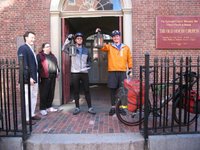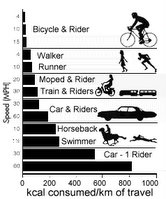
On Sunday, I reported that the
Ride for Climate bike tour is raising awareness of steps that individuals can take to reduce carbon emissions now. Among the steps being suggested were increasing the use of bicycles for transportation as well as the use of Energy Star rated appliances. Given that bicycles are humanity's most efficient form of land transportation, I was wondering why bikes are not included in the Energy Star program.
 Energy Star
Energy Star is a labeling program that was introduced in 1992 by the U.S. Environmental Protection Agency (EPA) to reduce greenhouse gas emissions by encouraging use of energy-efficient products. Although there are Energy Star ratings for products from dish washers to roofing materials, there is no category for transportation. Considering that transportation vehicles are among the greatest producers of greenhouse gases and other forms of pollution, it's disappointing that vehicles are left out of the Energy Star program and here's why.

The EPA rates motor vehicles for miles per gallon but a
mpg rating is only part of the story. What about the energy consumed to create motor vehicles, the huge caloric consumption motor vehicles require, the heat & chemical pollution generated by burning all those calories and the poisoning of food stuffs and ground water caused by the chemical pollutant that motor vehicles generate (both while the vehicles are in use and after the life cycle when the vehicles are discarded and in a landfill somewhere)?

Studies by various researchers have proven that there are many reasons to encourage bicycle usage. Just look at the following examples.
Dr. Marcia Lowe's figures of energy consumed per passenger mile (as published in "The Bicycle: Vehicle for a Small Planet" (
Worldwatch Institute, 1989)
Calories Burned Per Mile Of Travel:Automobile (1 occupant) - 1,860
Transit Bus - 920
Transit Rail - 885
Walking - 100
Bicycling - 35
DARPA (Defense Advanced Research Projects Agency) Study Comparing the efficiency of various modes of transportation for the
US Department of Defense:
| Transportation Efficiency Comparisons |
| Means of Transportation | Load Capacity | Daily Range | Speed | Daily Fuel Requirements |
| Walking | 50 pounds | 25 miles | @ 3 MPH | 3 lbs. MRE for rider
24 lbs. H2O for rider |
| Bicycling | 50 pounds | 75 miles | @ 10 MPH | 3 lbs. MRE for rider
24 lbs. H2O for rider |
| Horseback | 100 pounds | 100 miles | @ 15 MPH | 40 lbs. Hay
150lbs. H2o
3 lbs. MRE for rider
24 lbs. H2O for rider |
| Motorcycle | 100 pounds | 300 miles | @ 40 MPH | 55 lbs. Gas
? oil + pumping/storage
Equipment
3 lbs. MRE for rider
25 lbs. H2O for rider |
| 5-Ton Truck | 10,000 pounds | 300 miles | @ 40 MPH | 710 lbs. Dsl.
? oil + pumping/storage
Equipment
3 lbs. MRE for rider
25 lbs. H2O for rider |
| Armored Personnel Carrier | 10,000 pounds | 240 miles | @ 30 MPH | 1,234 lbs. Dsl.
? oil + pumping/storage
Equipment
3 lbs. MRE for rider
25 lbs. H2O for rider |
For a dizzying variety of stats that demonstrate the growing & dangerous impact of fossil fuel consumption, visit the
Transportation Energy Data Book, a project of the US Dept. of Energy. Another interesting resource I found is the
Victoria Transport Policy Institute's Transportation Cost and Benefit Analysis or for something a bit less scientific and at times amusing, try Mrk.'s 469 and counting....
Reasons We Must Eliminate Automobiles.
Labels: bicycle_efficiency, bike_stats, Energy_Star, Ride_for_Climate
















